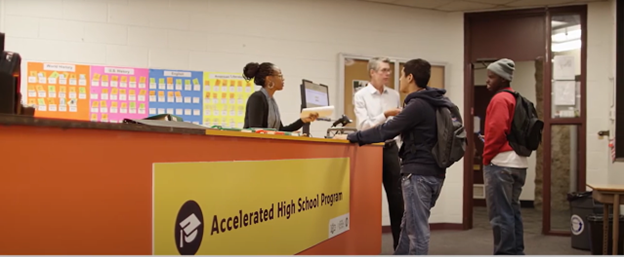Reinvigorating Secondary Education Access and Completion: SDCCE’s High School Diploma/Equivalency and Basic Skills Program
Submitted By: Jesus Rivas
San Diego Adult Education Regional Consortium
Website: https://sdcce.edu/hsged
Type of Practice: Learner Transition
Program Area(s): ABE / ASE
Region: San Diego - Imperial
Consortia Involved: San Diego Adult Education Regional Consortium
The Program of Practice
Across California and especially in the San Diego region, tens of thousands of adults lack a high school diploma or equivalency certificate—barriers that restrict their access to employment, postsecondary education, and self-sufficiency. At San Diego College of Continuing Education (SDCCE), enrollment in the Adult Secondary Education (ASE) program has declined by 12% from 2022/23 to 2023/24. Persistence has also dropped—most notably from 89% to 64% in the High School Diploma Program over four years. Meanwhile, access barriers tied to digital literacy, student placement, and community awareness continue to hinder both enrollment and student success.
SDCCE's ASE students often carry the weight of disrupted K-12 experiences, including poor grades, absenteeism, low socioeconomic status, and a lack of educational support at home. Additionally, local and statewide data reveal that Black, Hispanic, and Filipino students—particularly women—are disproportionately underrepresented or face greater barriers to completion. Coupled with outdated onboarding systems and growing technology gaps, these problems require bold, integrated solutions.
The Response
To address these systemic and localized challenges, SDCCE implemented a multi-faceted strategy grounded in data, equity, and community responsiveness:
• In-Person Course Reintroduction: After the pandemic forced a full shift online, in-person classes resumed in 2023 across campuses, including Chavez, ECC, and Mid-City, expanding learning modalities to meet diverse preferences and increase persistence.
• Special Projects Manager Role: A newly established position coordinates retention and wraparound support services across the ASE program, streamlining communication among counseling, instruction, and student services.
• Digital Equity Interventions: The program conducted extensive analysis of student tech access, revealing that 74% lacked personal devices and 28% had no internet at home. In response, the program invested in resources, advocated for campus tech bars, and introduced Canvas and hybrid readiness support.
• Targeted Onboarding and Outreach: Recognizing that many students enroll without understanding course pathways, ASE launched plans to create a clear, zip-code-informed outreach campaign, revamp website and placement tools, and strengthen collaboration with counseling and outreach teams.
• Restoration of Adult Basic Education (ABE): Courses will be reintroduced in 2025 to serve learners with literacy levels below sixth grade—those most at risk of falling through the cracks.
The Unique Features of the Program
Several innovative elements distinguish this program:
• Multimodal Access Strategy: The return of in-person instruction, hybrid course expansions, and integration with transitional housing facilities (e.g., WestCare) allow ASE to serve unique subpopulations such as justice-involved women.
• Proprietary Tech and Instructional Design: Adoption of platforms like Aztec, CommonLit, and Edmentum complements faculty-developed Canvas shells tailored to students' digital literacy levels, enabling asynchronous engagement and accelerated six-week course models.
• Equity-Centered Redesign: Leveraging the Peralta Equity Rubric, faculty redesign online learning experiences with intentional DEI practices. Moreover, curriculum integrates social justice themes, particularly in English and humanities instruction.
• Career and College Readiness Linkages: The ASE department aligns with SDCCE's Promise Program, WIOA-funded co-enrollment supports, and contextualized Career and Technical Education (CTE) offerings to foster meaningful transition pathways.
The Outcome
Despite overall enrollment declines reflective of broader statewide trends, the ASE program achieved key qualitative and structural milestones this past year:
• Restoration of Access: In-person attendance has steadily increased at reactivated sites. Student feedback overwhelmingly praised the return of face-to-face instruction as a driver of engagement.
• Improved Student Support Systems: The appointment of a Special Projects Manager established a foundational model for embedded case management and personalized retention strategies, now replicable across departments.
• Digital Literacy Data Mobilization: With 66% of ASE students preferring face-to-face learning and nearly 60% relying on phones as their main device, ASE now advocates for hybrid-focused course design and increased investment in tech access resources.
• Growing Multimodal Completion Options: Students now benefit from concurrent offerings in English and Spanish, multiple delivery formats (in-person, hybrid, online), and the opportunity to recover past coursework, increasing the likelihood of program completion.
• Equity Engagement: African American male enrollment increased from 1.052.16% to 2.344.25% in just two years, and female participation among African American students ages 30-39 has steadily risen for four consecutive years.

